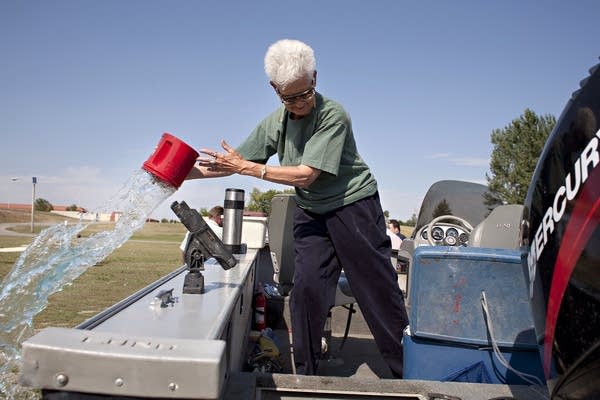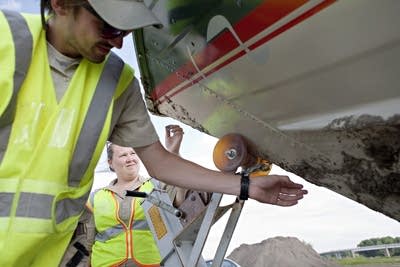For DNR invasive species inspectors, an uphill battle
Go Deeper.
Create an account or log in to save stories.
Like this?
Thanks for liking this story! We have added it to a list of your favorite stories.

This summer, zebra mussels have been found in more Minnesota lakes. The invasive species has now infested more than 60 lakes across the state.
Stopping the spread of aquatic invasive species like zebra mussels is the responsibility of the Department of Natural Resources.
The agency expanded its watercraft inspection program this year but faces a big challenge in a state with more than 10,000 lakes.
Minnesota has about 3,000 public access points to lakes and rivers. But the Minnesota DNR has only 118 inspectors charged with keeping invasive species out of the lakes and rivers.
Turn Up Your Support
MPR News helps you turn down the noise and build shared understanding. Turn up your support for this public resource and keep trusted journalism accessible to all.
DNR aquatic invasive species inspector Karl Koenig greets Gary Grosz of Grand Forks, N.D., as he pulls up to a public access along the Red River in East Grand Forks.
Koenig explains he's checking boats as part of the aquatic invasive species program.
"OK, hurry up," Grosz said.

"Keep the plug out when you leave and check for any vegetation or anything on the boat and you should be all set," Koenig said.
Grosz is in a hurry to get to his fishing spot, but he says he understands why it's important to take a few minutes to check his boat.
"It's fine, it's fine. Nobody wants to you know do stuff wrong. No, I try and do it right," Grosz said as he pushed his boat into the water.
The DNR says about 20 percent of boaters they check are violating laws by not pulling boat plugs, draining water or removing weeds from boats.
Koenig works lakes in west central Minnesota. He says Grosz is pretty typical of anglers he meets. They are in a hurry to get on the water, but they understand the need for inspections.
"I've been really impressed with the level of cooperation I see from the public, especially the fishing community," Koenig said. "I think with the folks who are out tubing or waterskiing or using personal watercraft, they typically express less interest in learning about what they can do, which to me is kind of disappointing."
Koenig is one of 23 inspectors covering thousands of lakes in the west central and northwest part of the state.

They focus on lakes already infested with invasive species like zebra mussels, or popular lakes with a lot of boaters coming from other lakes.
Regional supervisor Bruce Anspach says he hoped to have 30 inspectors this summer, but seven positions are still unfilled.
The DNR requires aquatic invasive species inspectors to be college interns, and Anspach says there are not enough applicants who meet the requirement. He says the agency is evaluating the rule.
The DNR announced earlier this year 150 aquatic invasive species inspectors would be hired this year. That goal later changed to 146. So far the agency has hired 118.
The inspectors can't issue citations, their primary goal is public education, teaching people to do their own inspections.

They also use have a handful of decontamination units they can use to wash boats with hot water if they find invasive species hitching a ride.
Anspach believes they are making progress on public awareness. He says few people claim ignorance of invasive species regulations.
"It's maybe one in a hundred," Anspach said. "Three years ago it was 10 out of 20; now a lot of people know what to do. It's just a matter of them getting in the habit of doing it."
Anspach says he has 50 public access points on a priority list in his region, so inspectors can realistically spend only a few hours a week at most locations.
"There's no way the Minnesota Department of Natural Resources is going to prevent it by themselves," he said. "We need everyone to help out. It's everyone's water, so everyone should want to."

The DNR is getting help from local governments and lake property owners in some areas. The state gave out a few grants this year for local governments to hire their own aquatic invasive species inspector. Along with the $7,500 grant comes authority to hire more inspectors with money raised locally.
Ken Grob, who heads the Aquatic Invasive Species Taskforce in Hubbard County, says they hired 13 local inspectors who focus on 12 lakes in the county. Statewide, the DNR says 174 aquatic invasive species inspectors were trained to assist local governments.
Grob says Hubbard county lake residents donated $55,000 and townships chipped in $20,000. He says locally funded inspectors are a short-term solution to a long-term problem.
"We figure we've got another year, maybe two at the most and these lake associations are going to start getting very tired of doing all the heavy lifting," Grob said. "We have got to find a long-term sustainable funding process."
Grob says protecting lakes is an economic necessity for a county like Hubbard, where lake property provides a large share of property tax revenue for local government.
"Between 55 and 60 percent of all the tax revenue comes from those limited set of people that live on the lake. I think that answers the question of why everybody has a stake in this and why it's important to protect our lakes."
Grob expects local governments to ask the Legislature for more state funding and for the authority to tax residents to fund aquatic invasive species programs.




